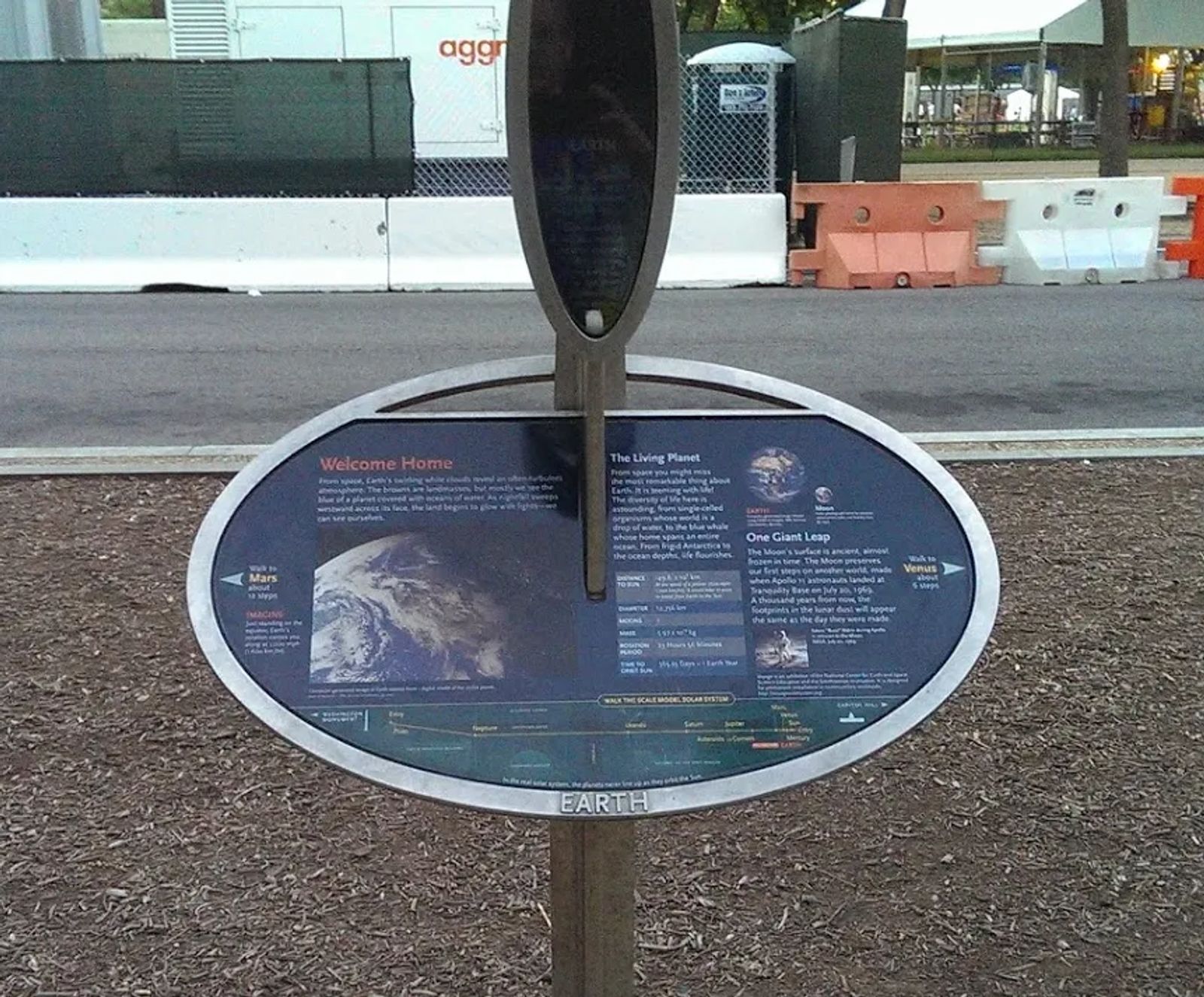
Weekly Gem #133 Our earth may be smaller than you think
Published 9/9/2017
Location: This 'hidden gem' starts outside the NE corner of the Air & Space Museum in Washington, DC, and continues over to the Smithsonian Castle (see the Clue Me! Map). The Earth may seem big after traveling to DC, especially after lots of walking. In that case, have a careful look at the "Voyage" display, which is a 1 to 10 billion scale model of our solar system, where the earth is merely a speck of dust. The longer you look, the more mind-blowing it becomes.
First, the objects are tiny, whereas the space between the objects is so immense that there's no way to describe it. No map or diagram or video comes anywhere close to the perspective you get from this display. There's no way 'around' it ... here come some numbers to help you visualize (taking poetic license to mix metric and imperial).
The sun in this display is 13.9 cm in diameter (5.47 in). 20.9 feet due west is a speck of 0.5 mm diameter, which is Mercury. Another 14.5 feet west is another spec, 1.21 mm diameter, Venus. At 48.6 feet is another spec, 1.27 mm diameter, Earth. Mars is 77 ft from the sun, 0.68 mm diameter. Jupiter is a 'giant,' not a mere speck, 1.4 cm in diameter, and 248.5 feet from the sun. Saturn, 1.165 cm, 473.1 feet. Picture that. A small cantaloupe here, a small marble about a football field and a half away. Then Uranus, 5.1 mm, 960 feet from the sun. Neptune, 4.9 mm, 1467 feet from the sun (almost 5 football fields). Pluto, 0.24 mm, almost 2000 feet from the sun.
These distances are the radius of each orbit, so picture this cantaloupe at the center of a circle 4000 feet across (3/4 of a mile). Scattered within this circle are the 9 'planets' along with a dusting of 'moons' and 'asteroids.'
This is our solar system. The entire complement of planetary bodies would fit in a pillbox, and they're all racing, at incredible velocity, in absolutely nothing. Back to full scale for a minute ... the Earth is flying 1.6 million miles every day!
Which brings us to the second mind blowing part of the Voyage, which is gravity. Explain to me ... how exactly does the cantaloupe hang on these marbles and grains that are so far away, and moving so fast? How does it do that for 4.6 billion years? Different sized specks, different distances, different speeds, all going around, and around, and around the cantaloupe, forever.
Here's the simple answer. None of those objects are moving in circles. They're all moving in perfectly straight lines, forever. They only seem to be moving in circles because they all have mass, are moving through spacetime (as opposed to space), and that mass plus movement is bending spacetime. Marbles and grains moving in a straight line on a surface that is curved by a grapefruit ... voilà! Orbits!
One (relatively) tiny additional step. The most distant planet, Pluto, is about 2000 feet away. The nearest star, Alpha Centauri, is over 13 million feet distant. To get to Pluto, you walk from Air & Space to the Smithsonian Castle. To get to Alpha Centauri you keep going until you reach the Golden Gate Bridge, with literally nothing between here and there.
Better pack a lunch!
The Voyage Solar System web site shares a well-known and very appropriate passage:
"I say!” murmured Horton. I’ve never heard tell
Of a small speck of dust that is able to yell.
So you know what I think?… Why I think that there must
Be someone on top of that small speck of dust!
Some sort of creature of very small size,
Too small to be seen by an elephant’s eyes…
—Dr. Seuss, Horton Hears a Who!"
.........
Here's the hidden gem entry from our Clue Me! map.
Clue
Earth
Description
The "Earth" station of the solar system model
Why It's Interesting
This is one of a series of stations that gives a very unique perspective of how our tiny earth fits into the other members of the solar system. You should actually start a few steps east, past the Sun, or a long ways west, past Pluto, and visit the entire solar system as you walk the mall.















